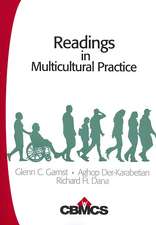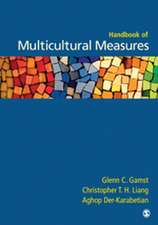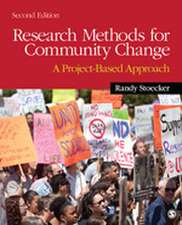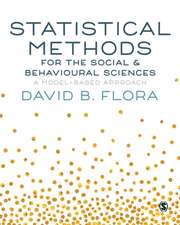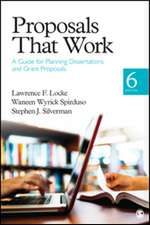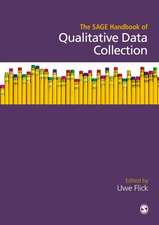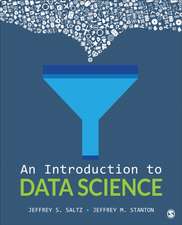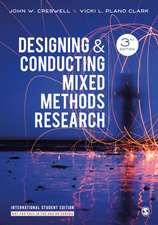Applied Multivariate Research: Design and Interpretation
Autor Lawrence S. Meyers, Glenn C. Gamst, Anthony J. Guarinoen Limba Engleză Hardback – 5 feb 2017
Preț: 1358.42 lei
Preț vechi: 1860.84 lei
-27% Nou
Puncte Express: 2038
Preț estimativ în valută:
259.95€ • 271.74$ • 219.67£
259.95€ • 271.74$ • 219.67£
Carte tipărită la comandă
Livrare economică 07-21 martie
Preluare comenzi: 021 569.72.76
Specificații
ISBN-13: 9781506329765
ISBN-10: 1506329764
Pagini: 1016
Dimensiuni: 203 x 254 x 42 mm
Greutate: 2 kg
Ediția:Third Edition
Editura: SAGE Publications
Colecția Sage Publications, Inc
Locul publicării:Thousand Oaks, United States
ISBN-10: 1506329764
Pagini: 1016
Dimensiuni: 203 x 254 x 42 mm
Greutate: 2 kg
Ediția:Third Edition
Editura: SAGE Publications
Colecția Sage Publications, Inc
Locul publicării:Thousand Oaks, United States
Recenzii
“A major strength of this text is that it covers the new features of the most recent SPSS® edition. With the step-by-step tutorial on the new features, students and empirical researchers can use it as a handbook when they conduct data analysis.”
Cuprins
Preface
About the Authors
PART I: FUNDAMENTALS OF MULTIVARIATE DESIGN
Chapter 1: An Introduction to Multivariate Design
1.1 The Use of Multivariate Designs
1.2 The Definition of the Multivariate Domain
1.3 The Importance of Multivariate Designs
1.4 The General Form of a Variate
1.5 The Type of Variables Combined to Form a Variate
1.6 The General Organization of the Book
Chapter 2: Some Fundamental Research Design Concepts
2.1 Populations and Samples
2.2 Variables and Scales of Measurement
2.3 Independent Variables, Dependent Variables, and Covariates
2.4 Between Subjects and Within Subjects Independent Variables
2.5 Latent Variables and Measured Variables
2.6 Endogenous and Exogenous Variables
2.7 Statistical Significance
2.8 Statistical Power
2.9 Recommended Readings
Chapter 3A: Data Screening
3A.1 Overview
3A.2 Value Cleaning
3A.3 Patterns of Missing Values
3A.4 Overview of Methods of Handling Missing Data
3A.5 Deletion Methods of Handling Missing Data
3A.6 Single Imputation Methods of Handling Missing Data
3A.7 Modern Imputation Methods of Handling Missing Data
3A.8 Recommendations for Handling Missing Data
3A.9 Outliers
3A.10 Using Descriptive Statistics in Data Screening
3A.11 Using Pictorial Representations in Data Screening
3A.12 Multivariate Statistical Assumptions Underlying the General Linear Model
3A.13 Data Transformations
3A.14 Recommended Readings
Chapter 3B: Data Screening Using IBM SPSS
3B.1 The Look of IBM SPSS
3B.2 Data Cleaning: All Variables
3B.3 Screening Quantitative Variables
3B.4 Missing Values: Overview
3B.5 Missing Value Analysis
3B.6 Multiple Imputation
3B.7 Mean Substitution as a Single Imputation Approach
3B.8 Univariate Outliers
3B.9 Normality
3B.10 Linearity
3B.11 Multivariate Outliers
3B.12 Screening Within Levels of Categorical Variables
3B.13 Reporting the Data Screening Results
PART II: BASIC AND ADVANCED REGRESSION ANALYSIS
Chapter 4A: Bivariate Correlation and Simple Linear Regression
4A.1 The Concept of Correlation
4A.2 Different Types of Relationships
4A.3 Statistical Significance of the Correlation Coefficient
4A.4 Strength of Relationship
4A.5 Pearson Correlation Using a Quantitative Variable and a Dichotomous Nominal Variable
4A.6 Simple Linear Regression
4A.7 Statistical Error in Prediction: Why Bother With Regression?
4A.8 How Simple Linear Regression Is Used
4A.9 Factors Affecting the Computed Pearson r and Regression Coefficients
4A.10 Recommended Readings
Chapter 4B: Bivariate Correlation and Simple Linear Regression Using IBM SPSS
4B.1 Bivariate Correlation: Analysis Setup
4B.2 Simple Linear Regression
4B.3 Reporting Simple Linear Regression Results
Chapter 5A: Multiple Regression Analysis
5A.1 General Considerations
5A.2 Statistical Regression Methods
5A.3 The Two Classes of Variables in a Multiple Regression Analysis
5A.4 Multiple Regression Research
5A.5 The Regression Equations
5A.6 The Variate in Multiple Regression
5A.7 The Standard (Simultaneous) Regression Method
5A.8 Partial Correlation
5A.9 The Squared Multiple Correlation
5A.10 The Squared Semipartial Correlation
5A.11 Structure Coefficients
5A.12 Statistical Summary of the Regression Solution
5A.13 Evaluating the Overall Model
5A.14 Evaluating the Individual Predictor Results
5A.15 Step Methods of Building the Model
5A.16 The Forward Method
5A.17 The Backward Method
5A.18 Backward Versus Forward Solutions
5A.19 The Stepwise Method
5A.20 Evaluation of the Statistical Methods
5A.21 Collinearity and Multicollinearity
5A.22 Recommended Readings
Chapter 5B: Multiple Regression Analysis Using IBM SPSS
5B.1 Standard Multiple Regression
5B.2 Stepwise Multiple Regression
Chapter 6A: Beyond Statistical Regression
6A.1 A Larger World of Regression
6A.2 Hierarchical Linear Regression
6A.3 Suppressor Variables
6A.4 Linear and Nonlinear Regression
6A.5 Dummy and Effect Coding
6A.6 Moderator Variables and Interactions
6A.7 Simple Mediation: A Minimal Path Analysis
6A.8 Recommended Readings
Chapter 6B: Beyond Statistical Regression Using IBM SPSS
6B.1 Hierarchical Linear Regression
6B.2 Polynomial Regression
6B.3 Dummy and Effect Coding
6B.4 Interaction Effects of Quantitative Variables in Regression
6B.5 Mediation
Chapter 7A: Canonical Correlation Analysis
7A.1 Overview
7A.2 Canonical Functions or Roots
7A.3 The Index of Shared Variance
7A.4 The Dynamics of Extracting Canonical Functions
7A.5 Accounting for Variance: Eigenvalues and Theta Values
7A.6 The Multivariate Tests of Statistical Significance
7A.7 Specifying the Amount of Variance Explained in Canonical Correlation Analysis
7A.8 Coefficients Associated With the Canonical Functions
7A.9 Interpreting the Canonical Functions
7A.10 Recommended Readings
Chapter 7B: Canonical Correlation Analysis Using IBM SPSS
7B.1 Canonical Correlation: Analysis Setup
7B.2 Canonical Correlation: Overview of Output
7B.3 Canonical Correlation: Multivariate Tests of Significance
7B.4 Canonical Correlation: Eigenvalues and Canonical Correlations
7B.5 Canonical Correlation: Dimension Reduction Analysis
7B.6 Canonical Correlation: How Many Functions Should Be Interpreted?
7B.7 Canonical Correlation: The Coefficients in the Output
7B.8 Canonical Correlation: Interpreting the Dependent Variates
7B.9 Canonical Correlation: Interpreting the Predictor Variates
7B.10 Canonical Correlation: Interpreting the Canonical Functions
7B.11 Reporting of the Canonical Correlation Analysis Results
Chapter 8A: Multilevel Modeling
8A.1 The Name of the Procedure
8A.2 The Rise of Multilevel Modeling
8A.3 The Defining Feature of Multilevel Modeling: Hierarchically Structured Data
8A.4 Nesting and the Independence Assumption
8A.5 The Intraclass Correlation as an Index of Clustering
8A.6 Consequences of Violating the Independence Assumption
8A.7 Some Ways in Which Level 2 Groups Can Differ
8A.8 The Random Coefficient Regression Model
8A.9 Centering the Variables
8A.10 The Process of Building the Multilevel Model
8A.11 Recommended Readings
Chapter 8B: Multilevel Modeling Using IBM SPSS
8B.1 Numerical Example
8B.2 Assessing the Unconditional Model
8B.3 Centering the Covariates
8B.4 Building the Multilevel Models: Overview
8B.5 Building the First Model
8B.6 Building the Second Model
8B.7 Building the Third Model
8B.8 Building the Fourth Model
8B.9 Reporting the Multilevel Modeling Results
Chapter 9A: Binary and Multinomial Logistic Regression and ROC Analysis
9A.1 Overview
9A.2 The Variables in Logistic Regression Analysis
9A.3 Assumptions of Logistic Regression
9A.4 Coding of the Binary Variables in Logistic Regression
9A.5 The Shape of the Logistic Regression Function
9A.6 Probability, Odds, and Odds Ratios
9A.7 The Logistic Regression Model
9A.8 Interpreting Logistic Regression Results in Simpler Language
9A.9 Binary Logistic Regression With a Single Binary Predictor
9A.10 Binary Logistic Regression With a Single Quantitative Predictor
9A.11 Binary Logistic Regression With a Categorical and a Quantitative Predictor
9A.12 Evaluating the Logistic Model
9A.13 Strategies for Building the Logistic Regression Model
9A.14 ROC Analysis
9A.15 Recommended Readings
Chapter 9B: Binary and Multinomial Logistic Regression and ROC Analysis Using IBM SPSS
9B.1 Binary Logistic Regression
9B.2 ROC Analysis
9B.3 Multinomial Logistic Regression
PART III: STRUCTURAL RELATIONSHIPS OF MEASURED AND LATENT VARIABLES
Chapter 10A: Principal Components Analysis and Exploratory Factor Analysis
10A.1 Orientation and Terminology
10A.2 Origins of Factor Analysis
10A.3 How Factor Analysis Is Used in Psychological Research
10A.4 The General Organization of This Chapter
10A.5 Where the Analysis Begins: The Correlation Matrix
10A.6 Acquiring Perspective on Factor Analysis
10A.7 Important Distinctions Within Our Generic Label of Factor Analysis
10A.8 The First Phase: Component Extraction
10A.9 Distances of Variables From a Component
10A.10 Principal Components Analysis Versus Factor Analysis
10A.11 Different Extraction Methods
10A.12 Recommendations Concerning Extraction
10A.13 The Rotation Process
10A.14 Orthogonal Factor Rotation Methods
10A.15 Oblique Factor Rotation
10A.16 Choosing Between Orthogonal and Oblique Rotation Strategies
10A.17 The Factor Analysis Output
10A.18 Interpreting Factors Based on the Rotated Matrices
10A.19 Selecting the Factor Solution
10A.20 Sample Size Issues
10A.21 Building Reliable Subscales
10A.22 Recommended Readings
Chapter 10B: Principal Components Analysis and Exploratory Factor Analysis Using IBM SPSS
10B.1 Numerical Example
10B.2 Preliminary Principal Components Analysis
10B.3 Principal Components Analysis With a Promax Rotation: Two-Component Solution
10B.4 ULS Analysis With a Promax Rotation: Two-Factor Solution
10B.5 Wrap-Up of the Two-Factor Solution
10B.6 Looking for Six Dimensions
10B.7 Principal Components Analysis With a Promax Rotation: Six-Component Solution
10B.8 ULS Analysis With a Promax Rotation: Six-Component Solution
10B.9 Principal Axis Factor Analysis With a Promax Rotation: Six-Component Solution
10B.10 Wrap-Up of the Six-Factor Solution
10B.11 Assessing Reliability: Our General Strategy
10B.12 Assessing Reliability: The Global Domains
10B.13 Assessing Reliability: The Six Item Sets Based on the ULS/Promax Structure
10B.14 Computing Scales Based on the ULS Promax Structure
10B.15 Using the Computed Variables in Further Analyses
10B.16 Reporting the Exploratory Factor Analysis Results
Chapter 11A: Confirmatory Factor Analysis
11A.1 Overview
11A.2 The General Form of a Confirmatory Model
11A.3 The Difference Between Latent and Measured Variables
11A.4 Contrasting Principal Components Analysis and Exploratory Factor Analysis With Confirmatory Factor Analysis
11A.5 Confirmatory Factor Analysis Is Theory Based
11A.6 The Logic of Performing a Confirmatory Factor Analysis
11A.7 Model Specification
11A.8 Model Identification
11A.9 Model Estimation
11A.10 Model Evaluation Overview
11A.11 Assessing Fit of Hypothesized Models
11A.12 Model Estimation: Assessing Pattern Coefficients
11A.13 Model Respecification
11A.14 General Considerations
11A.15 Recommended Readings
Chapter 11B: Confirmatory Factor Analysis Using IBM SPSS Amos
11B.1 Using IBM SPSS Amos
11B.2 Numerical Example
11B.3 Analysis Setup to Specify the Model
11B.4 Model Identification
11B.5 Structuring and Performing the Analysis
11B.6 Working With the Analysis Output
11B.7 Respecifying the Model
11B.8 Output From the Respecified Model
11B.9 Reporting Confirmatory Factor Analysis Results
Chapter 12A: Path Analysis: Multiple Regression Analysis
12A.1 Overview
12A.2 The Concept of a Path Model
12A.3 The Appeal of Path Over Multiple Regression Analysis
12A.4 Causality and Path Analysis
12A.5 The Roles Played by Variables in a Path Structure
12A.6 The Assumptions of Path Analysis
12A.7 Missing Values in Path Analysis
12A.8 The Multiple Regression Approach to Path Analysis
12A.9 Indirect and Total Effects
12A.10 Recommended Readings
Chapter 12B: Path Analysis: Multiple Regression Analysis Using IBM SPSS
12B.1 The Data Set and Model Used in Our Example
12B.2 Identifying the Variables in Each Analysis
12B.3 Predicting Months_Teaching
12B.4 Predicting Good_Teaching
12B.5 Reporting the Path Analysis Results
Chapter 13A: Path Analysis: Structural Equation Modeling
13A.1 Comparing Multiple Regression and Structural Equation Model Approaches
13A.2 Differences Between the Equations Underlying Multiple Regression and Structural Equation Model Procedures
13A.3 Configuring the Structural Model
13A.4 Identifying the Structural Equation Model
13A.5 Recommended Readings
Chapter 13B: Path Analysis: Structural Equation Modeling Using IBM SPSS Amos
13B.1 Overview
13B.2 The Data Set and Model Used in Our Example
13B.3 Analysis Setup
13B.4 The Analysis Output
13B.5 Reporting the Path Analysis Results
Chapter 14A: Structural Equation Modeling
14A.1 Overview of Structural Equation Modeling
14A.2 Model Quality and the Structural Aspects of the Model
14A.3 Latent Variables and Their Indicators
14A.4 Identifying Structural Equation Models
14A.5 Recommended Readings
Chapter 14B: Structural Equation Modeling Using IBM SPSS Amos
14B.1 Overview
14B.2 The Data Set and Model Used in Our Example
14B.3 Model Configuration and Analysis Setup
14B.4 Model Identification
14B.5 Generating the Output
14B.6 Analysis Output for the Model
14B.7 Configuring and Evaluating the Respecified Model
14B.8 Summary of the Results of the Model and Noting the Follow-up Analyses
14B.9 Assessing the Indirect Effects in the Full Model
14B.10 Assessing the Possibility of Having Obtained Complete Mediation in the Full Model
14B.11 Assessing Mediation Through Self_ Regulation
14B.12 Assessing Mediation Through Extrinsic_Goals
14B.13 Synthesis of the Results
14B.14 Reporting the SEM Results
Chapter 15A: Measurement and Structural Equation Modeling Invariance: Applying a Model to a Different Group
15A.1 Overview
15A.2 The General Strategy Used to Compare Groups
15A.3 The Omnibus Model Comparison Phase
15A.4 The Coefficient Comparison Phase
15A.5 Recommended Readings
Chapter 15B: Assessing Measurement and Structural Invariance for Confirmatory Factor Analysis and Structural Equation Models Using IBM SPSS Amos
15B.1 Overview and General Analysis Strategy
15B.2 The Data Set Used for Examining Invariance in Both the Confirmatory Factor Analysis and Structural Equation Model Examples
15B.3 Confirmatory Factor Analysis Invariance: Global Preliminary Analysis
15B.4 Confirmatory Factor Analysis Invariance: Group 1 (Rural) Analysis
15B.5 Confirmatory Factor Analysis Invariance: Group 2 Analysis
15B.6 Confirmatory Factor Analysis Invariance: Model Evaluation Setup
15B.7 Confirmatory Factor Analysis Invariance: Model Evaluation Output
15B.8 Reporting the Confirmatory Factor Analysis Invariance Results
15B.9 Structural Equation Model Invariance: Global Preliminary Analysis
15B.10 Structural Equation Model Invariance: Group 1 (Rural) Analysis
15B.11 Structural Equation Model Invariance: Group 2 Analysis
15B.12 Structural Equation Model Invariance: Model Evaluation Setup
15B.13 Structural Equation Model Invariance: Model Evaluation Output
15B.14 Reporting the Structural Equation Model Invariance Results
PART IV: CONSOLIDATING STIMULI AND CASES
Chapter 16A: Multidimensional Scaling
16A.1 Overview
16A.2 The Paired Comparison Method
16A.3 Dissimilarity Data in MDS
16A.4 Similarity/Dissimilarity Conceived as an Index of Distance
16A.5 Dimensionality in MDS
16A.6 Data Collection Methods
16A.7 Similarity Versus Dissimilarity
16A.8 Distance Models
16A.9 A Classification Schema for MDS Techniques
16A.10 Types of MDS Models
16A.11 Assessing Model Fit
16A.12 Recommended Readings
Chapter 16B: Multidimensional Scaling Using IBM SPSS
16B.1 The Structure of This Chapter
16B.2 Metric CMDS
16B.3 Nonmetric CMDS
16B.4 Metric WMDS
Chapter 17A: Cluster Analysis
17A.1 Introduction
17A.2 Two Types of Clustering
17A.3 Hierarchical Clustering
17A.4 k-Means Clustering
17A.5 Recommended Readings
Chapter 17B: Cluster Analysis Using IBM SPSS
17B.1 Hierarchical Cluster Analysis
17B.2 k-Means Cluster Analysis
PART V: COMPARING SCORES
Chapter 18A: Between Subjects Comparisons of Means
18A.1 Overview
18A.2 Historical Context
18A.3 A Brief Review of Some Basic Concepts
18A.4 Using Multiple Dependent Variables
18A.5 Evaluating Statistical Significance
18A.6 Strength of Effect
18A.7 Designs, Effects, and Partitioning of the Variance
18A.8 Post-ANOVA Comparisons of Means
18A.9 Hierarchical Analysis of Effects
18A.10 Covariance Analysis
18A.11 Recommended Readings
Chapter 18B: Between Subjects ANCOVA, MANOVA, and MANCOVA Using IBM SPSS
18B.1 One-Way ANOVA Without the Covariate
18B.2 One-Way ANCOVA
18B.3 Three-Group MANOVA
18B.4 Two-Group MANCOVA
18B.5 Two-Way MANOVA Without the Covariate
18B.6 Two-Way MANOVA Incorporating the Covariate (MANCOVA)
Chapter 19A: Discriminant Function Analysis
19A.1 Overview
19A.2 The Formal Roles of the Variables in Discriminant Function Analysis and MANOVA
19A.3 Discriminant Function Analysis and Logistic Analysis Compared
19A.4 Sample Size for Discriminant Analysis
19A.5 The Discriminant Model
19A.6 Extracting Multiple Discriminant Functions
19A.7 Dynamics of Extracting Discriminant Functions
19A.8 Interpreting the Discriminant Function
19A.9 Assessing Statistical Significance and the Relative Strength of the Discriminative Functions
19A.10 Using Discriminant Function Analysis for Classification
19A.11 Different Discriminant Function Methods
19A.12 Recommended Readings
Chapter 19B: Three-Group Discriminant Function Analysis Using IBM SPSS
19B.1 Numerical Example
19B.2 Analysis Setup
19B.3 Analysis Output
19B.4 Reporting the Results of a Three- Group Discriminant Function Analysis
Chapter 20A: Survival Analysis
20A.1 Overview
20A.2 The Dependent Variable in Survival Analysis
20A.3 Ordinary Least Squares Regression Versus Survival Analysis
20A.4 Censored Observations
20A.5 Overview of Analysis Techniques for Survival Analysis in IBM SPSS
20A.6 Life Table Analysis
20A.7 Kaplan–Meier (Product-Limit) Survival Function Analysis
20A.8 Cox Proportional Hazard Regression Model
20A.9 Recommended Readings
Chapter 20B: Survival Analysis Using IBM SPSS
20B.1 Numerical Example
20B.3 Kaplan–Meier (Product-Limit) Survival Function Analysis
20B.4 Cox Proportional Hazard Regression Model
References
Appendix A: Statistics Tables
Author Index
Subject Index
About the Authors
PART I: FUNDAMENTALS OF MULTIVARIATE DESIGN
Chapter 1: An Introduction to Multivariate Design
1.1 The Use of Multivariate Designs
1.2 The Definition of the Multivariate Domain
1.3 The Importance of Multivariate Designs
1.4 The General Form of a Variate
1.5 The Type of Variables Combined to Form a Variate
1.6 The General Organization of the Book
Chapter 2: Some Fundamental Research Design Concepts
2.1 Populations and Samples
2.2 Variables and Scales of Measurement
2.3 Independent Variables, Dependent Variables, and Covariates
2.4 Between Subjects and Within Subjects Independent Variables
2.5 Latent Variables and Measured Variables
2.6 Endogenous and Exogenous Variables
2.7 Statistical Significance
2.8 Statistical Power
2.9 Recommended Readings
Chapter 3A: Data Screening
3A.1 Overview
3A.2 Value Cleaning
3A.3 Patterns of Missing Values
3A.4 Overview of Methods of Handling Missing Data
3A.5 Deletion Methods of Handling Missing Data
3A.6 Single Imputation Methods of Handling Missing Data
3A.7 Modern Imputation Methods of Handling Missing Data
3A.8 Recommendations for Handling Missing Data
3A.9 Outliers
3A.10 Using Descriptive Statistics in Data Screening
3A.11 Using Pictorial Representations in Data Screening
3A.12 Multivariate Statistical Assumptions Underlying the General Linear Model
3A.13 Data Transformations
3A.14 Recommended Readings
Chapter 3B: Data Screening Using IBM SPSS
3B.1 The Look of IBM SPSS
3B.2 Data Cleaning: All Variables
3B.3 Screening Quantitative Variables
3B.4 Missing Values: Overview
3B.5 Missing Value Analysis
3B.6 Multiple Imputation
3B.7 Mean Substitution as a Single Imputation Approach
3B.8 Univariate Outliers
3B.9 Normality
3B.10 Linearity
3B.11 Multivariate Outliers
3B.12 Screening Within Levels of Categorical Variables
3B.13 Reporting the Data Screening Results
PART II: BASIC AND ADVANCED REGRESSION ANALYSIS
Chapter 4A: Bivariate Correlation and Simple Linear Regression
4A.1 The Concept of Correlation
4A.2 Different Types of Relationships
4A.3 Statistical Significance of the Correlation Coefficient
4A.4 Strength of Relationship
4A.5 Pearson Correlation Using a Quantitative Variable and a Dichotomous Nominal Variable
4A.6 Simple Linear Regression
4A.7 Statistical Error in Prediction: Why Bother With Regression?
4A.8 How Simple Linear Regression Is Used
4A.9 Factors Affecting the Computed Pearson r and Regression Coefficients
4A.10 Recommended Readings
Chapter 4B: Bivariate Correlation and Simple Linear Regression Using IBM SPSS
4B.1 Bivariate Correlation: Analysis Setup
4B.2 Simple Linear Regression
4B.3 Reporting Simple Linear Regression Results
Chapter 5A: Multiple Regression Analysis
5A.1 General Considerations
5A.2 Statistical Regression Methods
5A.3 The Two Classes of Variables in a Multiple Regression Analysis
5A.4 Multiple Regression Research
5A.5 The Regression Equations
5A.6 The Variate in Multiple Regression
5A.7 The Standard (Simultaneous) Regression Method
5A.8 Partial Correlation
5A.9 The Squared Multiple Correlation
5A.10 The Squared Semipartial Correlation
5A.11 Structure Coefficients
5A.12 Statistical Summary of the Regression Solution
5A.13 Evaluating the Overall Model
5A.14 Evaluating the Individual Predictor Results
5A.15 Step Methods of Building the Model
5A.16 The Forward Method
5A.17 The Backward Method
5A.18 Backward Versus Forward Solutions
5A.19 The Stepwise Method
5A.20 Evaluation of the Statistical Methods
5A.21 Collinearity and Multicollinearity
5A.22 Recommended Readings
Chapter 5B: Multiple Regression Analysis Using IBM SPSS
5B.1 Standard Multiple Regression
5B.2 Stepwise Multiple Regression
Chapter 6A: Beyond Statistical Regression
6A.1 A Larger World of Regression
6A.2 Hierarchical Linear Regression
6A.3 Suppressor Variables
6A.4 Linear and Nonlinear Regression
6A.5 Dummy and Effect Coding
6A.6 Moderator Variables and Interactions
6A.7 Simple Mediation: A Minimal Path Analysis
6A.8 Recommended Readings
Chapter 6B: Beyond Statistical Regression Using IBM SPSS
6B.1 Hierarchical Linear Regression
6B.2 Polynomial Regression
6B.3 Dummy and Effect Coding
6B.4 Interaction Effects of Quantitative Variables in Regression
6B.5 Mediation
Chapter 7A: Canonical Correlation Analysis
7A.1 Overview
7A.2 Canonical Functions or Roots
7A.3 The Index of Shared Variance
7A.4 The Dynamics of Extracting Canonical Functions
7A.5 Accounting for Variance: Eigenvalues and Theta Values
7A.6 The Multivariate Tests of Statistical Significance
7A.7 Specifying the Amount of Variance Explained in Canonical Correlation Analysis
7A.8 Coefficients Associated With the Canonical Functions
7A.9 Interpreting the Canonical Functions
7A.10 Recommended Readings
Chapter 7B: Canonical Correlation Analysis Using IBM SPSS
7B.1 Canonical Correlation: Analysis Setup
7B.2 Canonical Correlation: Overview of Output
7B.3 Canonical Correlation: Multivariate Tests of Significance
7B.4 Canonical Correlation: Eigenvalues and Canonical Correlations
7B.5 Canonical Correlation: Dimension Reduction Analysis
7B.6 Canonical Correlation: How Many Functions Should Be Interpreted?
7B.7 Canonical Correlation: The Coefficients in the Output
7B.8 Canonical Correlation: Interpreting the Dependent Variates
7B.9 Canonical Correlation: Interpreting the Predictor Variates
7B.10 Canonical Correlation: Interpreting the Canonical Functions
7B.11 Reporting of the Canonical Correlation Analysis Results
Chapter 8A: Multilevel Modeling
8A.1 The Name of the Procedure
8A.2 The Rise of Multilevel Modeling
8A.3 The Defining Feature of Multilevel Modeling: Hierarchically Structured Data
8A.4 Nesting and the Independence Assumption
8A.5 The Intraclass Correlation as an Index of Clustering
8A.6 Consequences of Violating the Independence Assumption
8A.7 Some Ways in Which Level 2 Groups Can Differ
8A.8 The Random Coefficient Regression Model
8A.9 Centering the Variables
8A.10 The Process of Building the Multilevel Model
8A.11 Recommended Readings
Chapter 8B: Multilevel Modeling Using IBM SPSS
8B.1 Numerical Example
8B.2 Assessing the Unconditional Model
8B.3 Centering the Covariates
8B.4 Building the Multilevel Models: Overview
8B.5 Building the First Model
8B.6 Building the Second Model
8B.7 Building the Third Model
8B.8 Building the Fourth Model
8B.9 Reporting the Multilevel Modeling Results
Chapter 9A: Binary and Multinomial Logistic Regression and ROC Analysis
9A.1 Overview
9A.2 The Variables in Logistic Regression Analysis
9A.3 Assumptions of Logistic Regression
9A.4 Coding of the Binary Variables in Logistic Regression
9A.5 The Shape of the Logistic Regression Function
9A.6 Probability, Odds, and Odds Ratios
9A.7 The Logistic Regression Model
9A.8 Interpreting Logistic Regression Results in Simpler Language
9A.9 Binary Logistic Regression With a Single Binary Predictor
9A.10 Binary Logistic Regression With a Single Quantitative Predictor
9A.11 Binary Logistic Regression With a Categorical and a Quantitative Predictor
9A.12 Evaluating the Logistic Model
9A.13 Strategies for Building the Logistic Regression Model
9A.14 ROC Analysis
9A.15 Recommended Readings
Chapter 9B: Binary and Multinomial Logistic Regression and ROC Analysis Using IBM SPSS
9B.1 Binary Logistic Regression
9B.2 ROC Analysis
9B.3 Multinomial Logistic Regression
PART III: STRUCTURAL RELATIONSHIPS OF MEASURED AND LATENT VARIABLES
Chapter 10A: Principal Components Analysis and Exploratory Factor Analysis
10A.1 Orientation and Terminology
10A.2 Origins of Factor Analysis
10A.3 How Factor Analysis Is Used in Psychological Research
10A.4 The General Organization of This Chapter
10A.5 Where the Analysis Begins: The Correlation Matrix
10A.6 Acquiring Perspective on Factor Analysis
10A.7 Important Distinctions Within Our Generic Label of Factor Analysis
10A.8 The First Phase: Component Extraction
10A.9 Distances of Variables From a Component
10A.10 Principal Components Analysis Versus Factor Analysis
10A.11 Different Extraction Methods
10A.12 Recommendations Concerning Extraction
10A.13 The Rotation Process
10A.14 Orthogonal Factor Rotation Methods
10A.15 Oblique Factor Rotation
10A.16 Choosing Between Orthogonal and Oblique Rotation Strategies
10A.17 The Factor Analysis Output
10A.18 Interpreting Factors Based on the Rotated Matrices
10A.19 Selecting the Factor Solution
10A.20 Sample Size Issues
10A.21 Building Reliable Subscales
10A.22 Recommended Readings
Chapter 10B: Principal Components Analysis and Exploratory Factor Analysis Using IBM SPSS
10B.1 Numerical Example
10B.2 Preliminary Principal Components Analysis
10B.3 Principal Components Analysis With a Promax Rotation: Two-Component Solution
10B.4 ULS Analysis With a Promax Rotation: Two-Factor Solution
10B.5 Wrap-Up of the Two-Factor Solution
10B.6 Looking for Six Dimensions
10B.7 Principal Components Analysis With a Promax Rotation: Six-Component Solution
10B.8 ULS Analysis With a Promax Rotation: Six-Component Solution
10B.9 Principal Axis Factor Analysis With a Promax Rotation: Six-Component Solution
10B.10 Wrap-Up of the Six-Factor Solution
10B.11 Assessing Reliability: Our General Strategy
10B.12 Assessing Reliability: The Global Domains
10B.13 Assessing Reliability: The Six Item Sets Based on the ULS/Promax Structure
10B.14 Computing Scales Based on the ULS Promax Structure
10B.15 Using the Computed Variables in Further Analyses
10B.16 Reporting the Exploratory Factor Analysis Results
Chapter 11A: Confirmatory Factor Analysis
11A.1 Overview
11A.2 The General Form of a Confirmatory Model
11A.3 The Difference Between Latent and Measured Variables
11A.4 Contrasting Principal Components Analysis and Exploratory Factor Analysis With Confirmatory Factor Analysis
11A.5 Confirmatory Factor Analysis Is Theory Based
11A.6 The Logic of Performing a Confirmatory Factor Analysis
11A.7 Model Specification
11A.8 Model Identification
11A.9 Model Estimation
11A.10 Model Evaluation Overview
11A.11 Assessing Fit of Hypothesized Models
11A.12 Model Estimation: Assessing Pattern Coefficients
11A.13 Model Respecification
11A.14 General Considerations
11A.15 Recommended Readings
Chapter 11B: Confirmatory Factor Analysis Using IBM SPSS Amos
11B.1 Using IBM SPSS Amos
11B.2 Numerical Example
11B.3 Analysis Setup to Specify the Model
11B.4 Model Identification
11B.5 Structuring and Performing the Analysis
11B.6 Working With the Analysis Output
11B.7 Respecifying the Model
11B.8 Output From the Respecified Model
11B.9 Reporting Confirmatory Factor Analysis Results
Chapter 12A: Path Analysis: Multiple Regression Analysis
12A.1 Overview
12A.2 The Concept of a Path Model
12A.3 The Appeal of Path Over Multiple Regression Analysis
12A.4 Causality and Path Analysis
12A.5 The Roles Played by Variables in a Path Structure
12A.6 The Assumptions of Path Analysis
12A.7 Missing Values in Path Analysis
12A.8 The Multiple Regression Approach to Path Analysis
12A.9 Indirect and Total Effects
12A.10 Recommended Readings
Chapter 12B: Path Analysis: Multiple Regression Analysis Using IBM SPSS
12B.1 The Data Set and Model Used in Our Example
12B.2 Identifying the Variables in Each Analysis
12B.3 Predicting Months_Teaching
12B.4 Predicting Good_Teaching
12B.5 Reporting the Path Analysis Results
Chapter 13A: Path Analysis: Structural Equation Modeling
13A.1 Comparing Multiple Regression and Structural Equation Model Approaches
13A.2 Differences Between the Equations Underlying Multiple Regression and Structural Equation Model Procedures
13A.3 Configuring the Structural Model
13A.4 Identifying the Structural Equation Model
13A.5 Recommended Readings
Chapter 13B: Path Analysis: Structural Equation Modeling Using IBM SPSS Amos
13B.1 Overview
13B.2 The Data Set and Model Used in Our Example
13B.3 Analysis Setup
13B.4 The Analysis Output
13B.5 Reporting the Path Analysis Results
Chapter 14A: Structural Equation Modeling
14A.1 Overview of Structural Equation Modeling
14A.2 Model Quality and the Structural Aspects of the Model
14A.3 Latent Variables and Their Indicators
14A.4 Identifying Structural Equation Models
14A.5 Recommended Readings
Chapter 14B: Structural Equation Modeling Using IBM SPSS Amos
14B.1 Overview
14B.2 The Data Set and Model Used in Our Example
14B.3 Model Configuration and Analysis Setup
14B.4 Model Identification
14B.5 Generating the Output
14B.6 Analysis Output for the Model
14B.7 Configuring and Evaluating the Respecified Model
14B.8 Summary of the Results of the Model and Noting the Follow-up Analyses
14B.9 Assessing the Indirect Effects in the Full Model
14B.10 Assessing the Possibility of Having Obtained Complete Mediation in the Full Model
14B.11 Assessing Mediation Through Self_ Regulation
14B.12 Assessing Mediation Through Extrinsic_Goals
14B.13 Synthesis of the Results
14B.14 Reporting the SEM Results
Chapter 15A: Measurement and Structural Equation Modeling Invariance: Applying a Model to a Different Group
15A.1 Overview
15A.2 The General Strategy Used to Compare Groups
15A.3 The Omnibus Model Comparison Phase
15A.4 The Coefficient Comparison Phase
15A.5 Recommended Readings
Chapter 15B: Assessing Measurement and Structural Invariance for Confirmatory Factor Analysis and Structural Equation Models Using IBM SPSS Amos
15B.1 Overview and General Analysis Strategy
15B.2 The Data Set Used for Examining Invariance in Both the Confirmatory Factor Analysis and Structural Equation Model Examples
15B.3 Confirmatory Factor Analysis Invariance: Global Preliminary Analysis
15B.4 Confirmatory Factor Analysis Invariance: Group 1 (Rural) Analysis
15B.5 Confirmatory Factor Analysis Invariance: Group 2 Analysis
15B.6 Confirmatory Factor Analysis Invariance: Model Evaluation Setup
15B.7 Confirmatory Factor Analysis Invariance: Model Evaluation Output
15B.8 Reporting the Confirmatory Factor Analysis Invariance Results
15B.9 Structural Equation Model Invariance: Global Preliminary Analysis
15B.10 Structural Equation Model Invariance: Group 1 (Rural) Analysis
15B.11 Structural Equation Model Invariance: Group 2 Analysis
15B.12 Structural Equation Model Invariance: Model Evaluation Setup
15B.13 Structural Equation Model Invariance: Model Evaluation Output
15B.14 Reporting the Structural Equation Model Invariance Results
PART IV: CONSOLIDATING STIMULI AND CASES
Chapter 16A: Multidimensional Scaling
16A.1 Overview
16A.2 The Paired Comparison Method
16A.3 Dissimilarity Data in MDS
16A.4 Similarity/Dissimilarity Conceived as an Index of Distance
16A.5 Dimensionality in MDS
16A.6 Data Collection Methods
16A.7 Similarity Versus Dissimilarity
16A.8 Distance Models
16A.9 A Classification Schema for MDS Techniques
16A.10 Types of MDS Models
16A.11 Assessing Model Fit
16A.12 Recommended Readings
Chapter 16B: Multidimensional Scaling Using IBM SPSS
16B.1 The Structure of This Chapter
16B.2 Metric CMDS
16B.3 Nonmetric CMDS
16B.4 Metric WMDS
Chapter 17A: Cluster Analysis
17A.1 Introduction
17A.2 Two Types of Clustering
17A.3 Hierarchical Clustering
17A.4 k-Means Clustering
17A.5 Recommended Readings
Chapter 17B: Cluster Analysis Using IBM SPSS
17B.1 Hierarchical Cluster Analysis
17B.2 k-Means Cluster Analysis
PART V: COMPARING SCORES
Chapter 18A: Between Subjects Comparisons of Means
18A.1 Overview
18A.2 Historical Context
18A.3 A Brief Review of Some Basic Concepts
18A.4 Using Multiple Dependent Variables
18A.5 Evaluating Statistical Significance
18A.6 Strength of Effect
18A.7 Designs, Effects, and Partitioning of the Variance
18A.8 Post-ANOVA Comparisons of Means
18A.9 Hierarchical Analysis of Effects
18A.10 Covariance Analysis
18A.11 Recommended Readings
Chapter 18B: Between Subjects ANCOVA, MANOVA, and MANCOVA Using IBM SPSS
18B.1 One-Way ANOVA Without the Covariate
18B.2 One-Way ANCOVA
18B.3 Three-Group MANOVA
18B.4 Two-Group MANCOVA
18B.5 Two-Way MANOVA Without the Covariate
18B.6 Two-Way MANOVA Incorporating the Covariate (MANCOVA)
Chapter 19A: Discriminant Function Analysis
19A.1 Overview
19A.2 The Formal Roles of the Variables in Discriminant Function Analysis and MANOVA
19A.3 Discriminant Function Analysis and Logistic Analysis Compared
19A.4 Sample Size for Discriminant Analysis
19A.5 The Discriminant Model
19A.6 Extracting Multiple Discriminant Functions
19A.7 Dynamics of Extracting Discriminant Functions
19A.8 Interpreting the Discriminant Function
19A.9 Assessing Statistical Significance and the Relative Strength of the Discriminative Functions
19A.10 Using Discriminant Function Analysis for Classification
19A.11 Different Discriminant Function Methods
19A.12 Recommended Readings
Chapter 19B: Three-Group Discriminant Function Analysis Using IBM SPSS
19B.1 Numerical Example
19B.2 Analysis Setup
19B.3 Analysis Output
19B.4 Reporting the Results of a Three- Group Discriminant Function Analysis
Chapter 20A: Survival Analysis
20A.1 Overview
20A.2 The Dependent Variable in Survival Analysis
20A.3 Ordinary Least Squares Regression Versus Survival Analysis
20A.4 Censored Observations
20A.5 Overview of Analysis Techniques for Survival Analysis in IBM SPSS
20A.6 Life Table Analysis
20A.7 Kaplan–Meier (Product-Limit) Survival Function Analysis
20A.8 Cox Proportional Hazard Regression Model
20A.9 Recommended Readings
Chapter 20B: Survival Analysis Using IBM SPSS
20B.1 Numerical Example
20B.3 Kaplan–Meier (Product-Limit) Survival Function Analysis
20B.4 Cox Proportional Hazard Regression Model
References
Appendix A: Statistics Tables
Author Index
Subject Index
Notă biografică
Lawrence S. Meyers earned his doctorate in experimental psychology and has been a Professor in the Psychology Department at California State University, Sacramento, for a number of years. He supervises research students and teaches research design courses as well as history of psychology at both the undergraduate and graduate levels. His areas of expertise include test development and validation.
Descriere
Provides full coverage of the wide range of multivariate topics that graduate students across the social and behavioral sciences encounter, using a conceptual, non-mathematical, approach.






